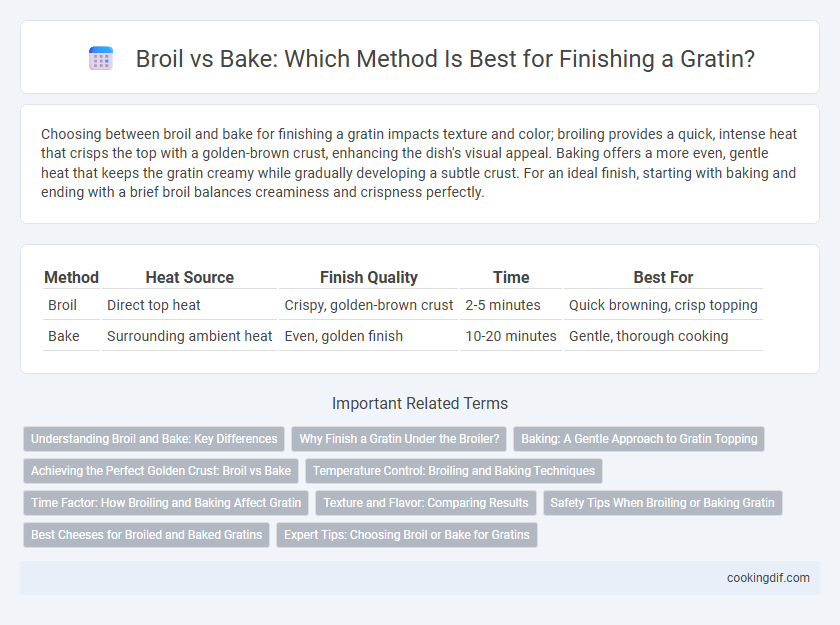Choosing between broil and bake for finishing a gratin impacts texture and color; broiling provides a quick, intense heat that crisps the top with a golden-brown crust, enhancing the dish's visual appeal. Baking offers a more even, gentle heat that keeps the gratin creamy while gradually developing a subtle crust. For an ideal finish, starting with baking and ending with a brief broil balances creaminess and crispness perfectly.
Table of Comparison
| Method | Heat Source | Finish Quality | Time | Best For |
|---|---|---|---|---|
| Broil | Direct top heat | Crispy, golden-brown crust | 2-5 minutes | Quick browning, crisp topping |
| Bake | Surrounding ambient heat | Even, golden finish | 10-20 minutes | Gentle, thorough cooking |
Understanding Broil and Bake: Key Differences
Broil uses intense, direct high heat from above, ideal for creating a crispy, golden-brown crust on a gratin's surface quickly without cooking the interior further. Bake applies consistent, surrounding heat at moderate temperatures, ensuring even cooking and melting of cheese throughout the gratin while gradually developing a tender crust. Choosing broil for finishing enhances texture contrast with a crunchy top layer, whereas bake maintains overall dish cohesion and thorough heat integration.
Why Finish a Gratin Under the Broiler?
Finishing a gratin under the broiler creates a golden, crispy crust that enhances both texture and flavor by rapidly caramelizing the cheese and topping ingredients. Broiling applies intense, direct heat from above, which ensures a perfectly browned surface without overcooking the creamy layers beneath. This method is preferred over baking for achieving an appealing contrast between the crunchy topping and smooth, rich interior.
Baking: A Gentle Approach to Gratin Topping
Baking offers a gentle approach to finishing gratin toppings, allowing even heat to develop a creamy, golden crust without burning. This method ensures the cheese melts uniformly and the breadcrumb layer crisps gradually, enhancing flavor complexity. Controlled baking temperatures preserve the dish's moisture, resulting in a tender interior beneath a perfectly browned surface.
Achieving the Perfect Golden Crust: Broil vs Bake
Broiling provides intense, direct heat ideal for achieving a crisp, golden crust quickly on gratin dishes, creating a visually appealing and texturally satisfying finish. Baking, on the other hand, applies even, consistent heat that gently melts cheese and melds flavors while gradually browning the top. Choosing between broil and bake depends on desired texture and time, with broiling preferred for a rapid, caramelized crust and baking for thorough, uniform cooking.
Temperature Control: Broiling and Baking Techniques
Broiling for gratin involves using intense, direct heat at temperatures often exceeding 500degF to achieve a crispy, browned top quickly, demanding precise timing to prevent burning. Baking employs consistent, moderate temperatures around 350degF to 400degF, allowing even cooking and gradual browning without overcooking the interior. Temperature control in broiling requires constant monitoring for optimal caramelization, whereas baking ensures uniform heat distribution for a tender, fully cooked gratin.
Time Factor: How Broiling and Baking Affect Gratin
Broiling gratin typically takes 2 to 5 minutes, providing a quick, intense heat that crisps the top layer without overcooking the interior. Baking requires 20 to 40 minutes at moderate temperatures, allowing even heat distribution that melts cheese thoroughly and cooks fillings evenly. Choosing broil reduces overall finishing time but demands close attention to prevent burning, while baking ensures uniform texture with longer cook times.
Texture and Flavor: Comparing Results
Broiling a gratin creates a crisp, golden-brown crust with a slightly charred flavor that enhances texture contrast and intensifies savory notes. Baking finishes the dish more evenly, yielding a softer, creamy texture beneath the crust and preserving subtle, blended flavors. Broil offers a more robust, textured finish, while bake provides a gentle, uniform doneness ideal for delicate ingredients.
Safety Tips When Broiling or Baking Gratin
When finishing a gratin, broiling achieves a crispy top layer by exposing it to high direct heat, while baking ensures even cooking through surrounding hot air. To ensure safety when broiling, always monitor the dish closely to prevent burning, use oven mitts to handle hot cookware, and keep the oven rack at the recommended distance from the broiler. When baking gratin, avoid placing flammable items near the oven, use heat-resistant dishes, and ensure proper ventilation to prevent heat buildup and reduce the risk of fire.
Best Cheeses for Broiled and Baked Gratins
Broiling gratins produces a crisp, golden crust perfect for high-moisture cheeses like mozzarella or raclette that melt evenly under intense heat. Baking suits firmer cheeses such as Gruyere, Parmesan, and aged cheddar, which develop deep, nutty flavors and a browned top without burning. Choosing cheese types according to finishing method enhances texture and flavor, creating the ideal gratin experience.
Expert Tips: Choosing Broil or Bake for Gratins
Broil delivers intense, direct heat ideal for creating a crisp, golden crust on gratins, while baking provides even, consistent heat that cooks the interior thoroughly. Experts recommend broiling for the final 2-3 minutes to achieve a perfectly caramelized top without overcooking the dish. Monitoring closely during broiling prevents burning, ensuring a balanced texture between creamy layers and a crunchy surface.
Broil vs Bake for finishing Infographic

 cookingdif.com
cookingdif.com